Analysis of the Thermal Behavior of a New Structure of Protected Agriculture Established in a Region of Tropical Climate Conditions
Abstract
:1. Introduction
2. Materials and Methods
2.1. Description of the Structure and Experimental Arrangement
2.2. Physical and Mathematical Model and Boundary Conditions
2.3. Developed Simulation Scenarios
2.4. Model Validation
3. Results
3.1. Test of Independence of Numerical Grid
3.2. Numerical Model Validation
3.3. Air Flow Patterns
3.4. Spatial Temperature Distribution
4. Conclusions
Author Contributions
Funding
Institutional Review Board Statement
Informed Consent Statement
Data Availability Statement
Acknowledgments
Conflicts of Interest
References
- Ortíz-Vázquez, C.I.; Lilia Irene, R.; Pérez-Robles, J.F.; Soto-Zarazúa, J.; Rico-García, E.; De La Torregea, G.A. Analysis of large commercial greenhouses in warm climates using cfd and bayesian networks. Artic. J. Glob. Ecol. Environ. 2016, 5, 91–96. [Google Scholar]
- Rico-García, E.; Soto-Zarazua, G.M.; Alatorre-Jacome, O.; De La Torre-Gea, G.A.; Gomez-Melendez, D.G. Aerodynamic study of greenhouses using computational fluid dynamics. Int. J. Phys. Sci. 2011, 6, 6541–6547. [Google Scholar] [CrossRef]
- Villagrán, E.; Bojacá, C.; Akrami, M. Contribution to the Sustainability of Agricultural Production in Greenhouses Built on Slope Soils: A Numerical Study of the Microclimatic Behavior of a Typical Colombian Structure. Sustainability 2021, 13, 4748. [Google Scholar] [CrossRef]
- Rajagopalan, P. Advances in Wind Tunnel and CFD Analysis for Building Design in Hot–Humid Climates. In Building in Hot and Humid Regions; Springer: Singapore, 2020; pp. 151–164. [Google Scholar] [CrossRef]
- Villagrán, E.A.; Noreña, J.E. Microclimatic behavior of a screen house proposed for horticultural production in low-altitude tropical climate conditions. Comun. Sci. 2020, 11, e3350. [Google Scholar] [CrossRef]
- Villagrán, E. Implementation of ventilation towers in a greenhouse established in low altitude tropical climate conditions: Numerical approach to the behavior of the natural ventilation. Rev. Ceres 2021, 68, 10–22. [Google Scholar] [CrossRef]
- Sarkar, D.; Kar, S.K.; Chattopadhyay, A.; Rakshit, A.; Tripathi, V.K.; Dubey, P.K.; Abhilash, P.C. Low input sustainable agriculture: A viable climate-smart option for boosting food production in a warming world. Ecol. Indic. 2020, 115, 106412. [Google Scholar] [CrossRef]
- Gameda, S.; Loboguerrero, R.A.M.; Boa, D.; Martínez Barón, D.; Martiz, G.; Sierra, Y.; Vanegas, L. Estado del Arte en Cambio Climático, Agricultura y Seguridad Alimentaria en Panamá. 2014. Available online: https://ccafs.cgiar.org/fr/node/91597 (accessed on 17 April 2021).
- Villagrán, E.; Leon, R.; Rodriguez, A.; Jaramillo, J. 3D Numerical Analysis of the Natural Ventilation Behavior in a Colombian Greenhouse Established in Warm Climate Conditions. Sustainability 2020, 12, 8101. [Google Scholar] [CrossRef]
- Arguello-Delgado, J.F.; Monge-Pérez, J.E.; Solórzano-Quintana, M.; Benavides, C.; López, A.J.; Carmona, G.; Mora, J.R.; Mo-lina-Bravo, R.; Cordero, R. Efecto del Cambio Climático en la Producción de Hortalizas en Costa Rica. 2018. Available online: https://repositoriotec.tec.ac.cr/handle/2238/9985 (accessed on 13 April 2021).
- Bowles, T.M.; Mooshammer, M.; Socolar, Y.; Calderón, F.; Cavigelli, M.A.; Culman, S.W.; Deen, W.; Drury, C.F.; Garcia, A.; Gaudin, A.C.M.; et al. Long-Term Evidence Shows that Crop-Rotation Diversification Increases Agricultural Resilience to Adverse Growing Conditions in North America. One Earth 2020, 2, 284–293. [Google Scholar] [CrossRef]
- Maraveas, C. Environmental Sustainability of Greenhouse Covering Materials. Sustainability 2019, 11, 6129. [Google Scholar] [CrossRef] [Green Version]
- Imadi, S.R.; Shazadi, K.; Gul, A.; Hakeem, K.R. Sustainable Crop Production System. In Plant, Soil and Microbes; Springer: Cham, Switzerland, 2016; pp. 103–116. [Google Scholar] [CrossRef]
- García-Sánchez, E.I.; Vargas-Canales, J.M.; Palacios-Rangel, M.I.; Aguilar-Ávila, J. Sistema de innovación como marco analítico de la agricultura protegida en la región centro de México. Cuad. Desarro. Rural. 2019, 15, 93–116. [Google Scholar] [CrossRef]
- Villagrán, E.A.; Romero, E.J.B.; Bojacá, C.R. Transient CFD analysis of the natural ventilation of three types of greenhouses used for agricultural production in a tropical mountain climate. Biosyst. Eng. 2019, 188, 288–304. [Google Scholar] [CrossRef]
- McCartney, L.; Orsat, V.; Lefsrud, M.G. An experimental study of the cooling performance and airflow patterns in a model Natural Ventilation Augmented Cooling (NVAC) greenhouse. Biosyst. Eng. 2018, 174, 173–189. [Google Scholar] [CrossRef]
- Bartzanas, T.; Boulard, T.; Kittas, C. Numerical simulation of the airflow and temperature distribution in a tunnel greenhouse equipped with insect-proof screen in the openings. Comput. Electron. Agric. 2002, 4, 207–221. [Google Scholar] [CrossRef]
- Baxevanou, C.; Fidaros, D.; Bartzanas, T.; Kittas, C. Yearly numerical evaluation of greenhouse cover materials. Comput. Electron. Agric. 2017, 149, 54–70. [Google Scholar] [CrossRef]
- Akrami, M.; Salah, A.H.; Javadi, A.A.; Fath, H.E.; Hassanein, M.J.; Farmani, R.; Negm, A. Towards a Sustainable Greenhouse: Review of Trends and Emerging Practices in Analysing Greenhouse Ventilation Requirements to Sustain Maximum Agricultural Yield. Sustainability 2020, 12, 2794. [Google Scholar] [CrossRef] [Green Version]
- Villagrán, E.; Bojacá, C.R. Numerical evaluation of passive strategies for nocturnal climate optimization in a greenhouse designed for rose production (Rosa spp.). Ornam. Hortic. 2019, 25, 351–364. [Google Scholar] [CrossRef] [Green Version]
- Villagrán, E.; Ramirez, R.; Rodriguez, A.; Pacheco, R.L.; Jaramillo, J. Simulation of the Thermal and Aerodynamic Behavior of an Established Screenhouse under Warm Tropical Climate Conditions: A Numerical Approach. Int. J. Sustain. Dev. Plan. 2020, 15, 487–499. [Google Scholar] [CrossRef]
- Akrami, M.; Mutlum, C.D.; Javadi, A.A.; Salah, A.H.; Fath, H.; Dibaj, M.; Farmani, R.; Mohammed, R.H.; Negm, A. Analysis of Inlet Configurations on the Microclimate Conditions of a Novel Standalone Agricultural Greenhouse for Egypt Using Computational Fluid Dynamics. Sustainability 2021, 13, 1446. [Google Scholar] [CrossRef]
- Norton, T.; Sun, D.W.; Grant, J.; Fallon, R.; Dodd, V. Applications of computational fluid dynamics (CFD) in the modelling and design of ventilation systems in the agricultural industry: A review. Bioresour. Technol. 2007, 98, 2386–2414. [Google Scholar] [CrossRef]
- Villagrán, E.; Bojacá, C. Study using a CFD approach of the efficiency of a roof ventilation closure system in a multi-tunnel greenhouse for nighttime microclimate optimization. Rev. Ceres 2020, 67, 345–356. [Google Scholar] [CrossRef]
- Liu, X.; Li, H.; Li, Y.; Yue, X.; Tian, S.; Li, T. Effect of internal surface structure of the north wall on Chinese solar greenhouse thermal microclimate based on computational fluid dynamics. PLoS ONE 2020, 15, e0231316. [Google Scholar] [CrossRef] [Green Version]
- Chen, W.; Liu, W. Numerical simulation of the airflow and temperature distribution in a lean-to greenhouse. Renew. Energy 2006, 31, 517–535. [Google Scholar] [CrossRef]
- Senhaji, A.; Mouqallid, M.; Majdoubi, H. CFD Assisted Study of Multi-Chapels Greenhouse Vents Openings Effect on Inside Airflow Circulation and Microclimate Patterns. Open J. Fluid Dyn. 2019, 9, 119–139. [Google Scholar] [CrossRef] [Green Version]
- Villagrán, E.A.; Bojacá, C.R. CFD Simulation of the Increase of the Roof Ventilation Area in a Traditional Colombian Greenhouse: Effect on Air Flow Patterns and Thermal Behavior. Int. J. Heat Technol. 2019, 37, 881–892. [Google Scholar] [CrossRef]
- Román-Roldán, N.I.; López-Ortiz, A.; Ituna-Yudonago, J.F.; García-Valladares, O.; Pilatowsky-Figueroa, I. Computational fluid dynamics analysis of heat transfer in a greenhouse solar dryer “chapel-type” coupled to an air solar heating system. Energy Sci. Eng. 2019, 7, 1123–1139. [Google Scholar] [CrossRef]
- Aguilar-Rodriguez, C.E.; Flores-Velazquez, J.; Ojeda-Bustamante, W.; Rojano, F.; Iñiguez-Covarrubias, M. Valuation of the Energy Performance of a Greenhouse with an Electric Heater Using Numerical Simulations. Processes 2020, 8, 600. [Google Scholar] [CrossRef]
- Villagrán, E.A.; Bojacá, C.R. Effects of surrounding objects on the thermal performance of passively ventilated greenhouses. J. Agric. Eng. 2019, 50, 20–27. [Google Scholar] [CrossRef]
- Reynafarje, X.; Villagrán, E.A.; Bojacá, C.R.; Gil, R.; Schrevens, E. Simulation and validation of the airflow inside a naturally ventilated greenhouse designed for tropical conditions. Acta Hortic. 2020, 1271, 55–62. [Google Scholar] [CrossRef]
- Baeza, E.J.; Sapounas, A.; Stanghellini, C.; Bonachela, S.; Hernández, J.; Montero, J.I.; López, J.C.; Granados, M.R.; Muñoz, P.; Lorenzo, P.; et al. Numerical simulation of the effect of different mulches on the heat storage capacity of a Mediterranean greenhouse soil. Acta Hortic. 2017, 1170, 119–128. [Google Scholar] [CrossRef]
- Tominaga, Y.; Mochida, A.; Yoshie, R.; Kataoka, H.; Nozu, T.; Yoshikawa, M.; Shirasawa, T. AIJ guidelines for practical applications of CFD to pedestrian wind environment around buildings. J. Wind. Eng. Ind. Aerodyn. 2008, 96, 1749–1761. [Google Scholar] [CrossRef]
- Li, H.; Li, Y.; Yue, X.; Liu, X.; Tian, S.; Li, T. Evaluation of airflow pattern and thermal behavior of the arched greenhouses with designed roof ventilation scenarios using CFD simulation. PLoS ONE 2020, 15, e0239851. [Google Scholar] [CrossRef]
- Villagrán, E.; Henao-Rojas, J.C.; Franco, G. Thermo-Environmental Performance of Four Different Shapes of Solar Greenhouse Dryer with Free Convection Operating Principle and No Load on Product. Fluids 2021, 6, 183. [Google Scholar] [CrossRef]
- Villagrán, E.A.; Matarrita, R.; Jaramillo Noreña, J.E.; Leon, R. Comportamiento microclimático diurno, en temporada seca, de tres estructuras para agricultura protegida en el trópico seco. UNED Res. J. 2020, 12, e2854. [Google Scholar] [CrossRef]
- ANSYS-Fluent User’s Guide, ANSYS Fluent Theory Guide, Release 18.2. 2013. Available online: https://doi.org/10.1016/0140-3664(87)90311-2 (accessed on 12 March 2021).
- Flores-Velazquez, J.; Ojeda, W.; Villarreal-Guerrero, F.; Rojano, A. Effect of crops on natural ventilation in a screenhouse evaluated by CFD simulations. Acta Hortic. 2017, 1170, 95–101. [Google Scholar] [CrossRef]
- Teitel, T.; Garcia-Teruel, M.; Ibanez, P.F.; Tanny, J.; Laufer, S.; Levi, A.; Antler, A. Airflow characteristics and patterns in screenhouses covered with fine-mesh screens with either roof or roof and side ventilation. Biosyst. Eng. 2015, 131, 1–14. [Google Scholar] [CrossRef]
- Sun, Y.; Bao, E.; Zhu, C.; Yan, L.; Cao, Y.; Zhang, X.; Li, J.; Jing, H.; Zou, Z. Effects of window opening style on inside environment of solar greenhouse based on CFD simulation. Int. J. Agric. Biol. Eng. 2020, 13, 53–59. [Google Scholar] [CrossRef]
- Aich, W.; Kolsi, L.; Borjini, M.N.; Ben Aissia, H.; Oztop, H.; Abu-Hamdeh, N. Three dimensional CFD analysis of Buoyancy-driven natural ventilation and entropy generation in a prismatic greenhouse. Therm. Sci. 2016, 52. [Google Scholar] [CrossRef]
- Akrami, M.; Arzani, M. Inheritance of fruit yield and quality in melon (Cucumis melo L.) grown under field salinity stress. Sci. Rep. 2019, 9, 1–13. [Google Scholar] [CrossRef]
- Moreno, J.J.M.; Pol, A.P.; Abad, A.S.; Blasco, B.C. Using the R-MAPE index as a resistant measure of forecast accuracy. Psicothema 2013, 25. [Google Scholar] [CrossRef]
- Flores-Velazquez, F.; Guerrero, F.V.; Lopez, I.L.; Montero, J.I.; Piscia, D. 3-Dimensional thermal analysis of a screenhouse with plane and multispan roof by using computational fluid dynamics (CFD). Acta Hortic. 2013, 1008, 151–158. [Google Scholar] [CrossRef]
- Teitel, M.; Montero, J.I.; Baeza, E.J. Greenhouse design: Concepts and trends. Acta Hortic. 2011, 952, 605–620. [Google Scholar] [CrossRef]
- McCartney, L.; Lefsrud, M.G. Field trials of the Natural Ventilation Augmented Cooling (NVAC) greenhouse. Biosyst. Eng. 2018, 174, 159–172. [Google Scholar] [CrossRef]
- Reyes-Rosas, A.; Molina-Aiz, F.D.; Valera, D.L.; López, A.; Khamkure, S. Development of a single energy balance model for prediction of temperatures inside a naturally ventilated greenhouse with polypropylene soil mulch. Comput. Electron. Agric. 2017, 142, 9–28. [Google Scholar] [CrossRef]
- López, A.; Valera, D.L.; Molina-Aiz, F. Sonic Anemometry to Measure Natural Ventilation in Greenhouses. Sensors 2011, 11, 9820–9838. [Google Scholar] [CrossRef]
- Molina-Aiz, F.D.; Valera, D.L.; Álvarez, A.J. Measurement and simulation of climate inside Almería-type greenhouses using computational fluid dynamics. Agric. For. Meteorol. 2004, 125, 33–51. [Google Scholar] [CrossRef]
- Villagrán, E. Two-Dimensional Numerical Study of the Microclimate Generated in Three Screenhouses for the Climatic Conditions of the Colombian Caribbean. Int. J. Heat Technol. 2021, 39, 459–468. [Google Scholar] [CrossRef]
- Flores-Velazquez, J.; Montero, J.I. Computational fluid dynamics (CFD) study of large scale screenhouses. Acta Hortic. 2008, 797, 117–122. [Google Scholar] [CrossRef]
- Teitel, M.; Liang, H.; Vitoshkin, H.; Tanny, J.; Ozer, S. Airflow patterns and turbulence characteristics above the canopy of a tomato crop in a roof-ventilated insect-proof screenhouse. Biosyst. Eng. 2020, 190, 184–200. [Google Scholar] [CrossRef]
- Valera, D.L.; Álvarez, A.J.; Molina, F.D. Aerodynamic analysis of several insect-proof screens used in greenhouses. Span. J. Agric. Res. 2006, 4, 273–279. [Google Scholar] [CrossRef]
- Tanny, J.; Haijun, L.; Cohen, S. Airflow characteristics, energy balance and eddy covariance measurements in a banana screenhouse. Agric. For. Meteorol. 2006, 139, 105–118. [Google Scholar] [CrossRef]
- Vega, C.P.; Arias, J.A.R.; Cruz, I.L.L. Caracteristicas aerodinamicas de mallas anti-insectos usadas en ventanas de invernaderos en Mexico. Rev. Mex. Cienc. Agrícolas 2016, 7, 493–506. [Google Scholar] [CrossRef] [Green Version]
- Bournet, P.E.; Ould Khaoua, S.A.; Boulard, T. Numerical prediction of the effect of vent arrangements on the ventilation and energy transfer in a multi-span glasshouse using a bi-band radiation model. Biosyst. Eng. 2007, 98, 224–234. [Google Scholar] [CrossRef]
- Parra, J.P.; Baeza, E.; Montero, J.I.; Bailey, B.J. Natural Ventilation of Parral Greenhouses. Biosyst. Eng. 2004, 87, 355–366. [Google Scholar] [CrossRef]
- Villagrán, E.A.; Bojacá, C.R. Study of natural ventilation in a Gothic multi-tunnel greenhouse designed to produce rose (Rosa spp.) in the high-Andean tropic. Ornam. Hortic. 2019, 25, 133–143. [Google Scholar] [CrossRef] [Green Version]
- Majdoubi, H.; Boulard, T.; Fatnassi, H.; Senhaji, A.; Elbahi, S.; Demrati, H.; Mouqallid, M.; Bouirden, L. Canary Greenhouse CFD Nocturnal Climate Simulation. Open J. Fluid Dyn. 2016, 6, 88–100. [Google Scholar] [CrossRef] [Green Version]
- Mesmoudi, K.; Meguallati, K.H.; Bournet, P.E. Effect of the greenhouse design on the thermal behavior and microclimate distribution in greenhouses installed under semi-arid climate. Heat Transf. Asian Res. 2017, 46, 1294–1311. [Google Scholar] [CrossRef]
- Bojacá, C.R.; Gil, R.; Cooman, A. Use of geostatistical and crop growth modelling to assess the variability of greenhouse tomato yield caused by spatial temperature variations. Comput. Electron. Agric. 2009, 65, 219–227. [Google Scholar] [CrossRef]
- Villagrán, E.; Bojacá, C. Analysis of the microclimatic behavior of a greenhouse used to produce carnation (Dianthus caryophyllus L.). Ornam. Hortic. 2020, 26, 190–204. [Google Scholar] [CrossRef]
- Taki, M.; Ajabshirchi, Y.; Ranjbar, S.F.; Rohani, A.; Matloobi, M. Modeling and experimental validation of heat transfer and energy consumption in an innovative greenhouse structure. Inf. Process. Agric. 2016, 3, 157–174. [Google Scholar] [CrossRef] [Green Version]
- Fernández, M.D.; Bonachela, S.; Orgaz, F.; Thompson, R.; López, J.C.; Granados, M.; Fereres, E. Measurement and estimation of plastic greenhouse reference evapotranspiration in a Mediterranean climate. Irrig. Sci. 2010, 28, 497–509. [Google Scholar] [CrossRef] [Green Version]
- Saberian, A.; Sajadiye, S.M. The effect of dynamic solar heat load on the greenhouse microclimate using CFD simulation. Renew. Energy 2019, 138, 722–737. [Google Scholar] [CrossRef]
- Montaño-Rodríguez, S.; Villagrán-Munar, E.A.; Osorio-Fiaga, D.F.; Bojacá-Aldana, C.R.; Velásquez-Vargas, W.L. Numeric simulation of macrotunnel greenhouse thermic behavior used for edible mushrooms under tropical weather conditions. Rev. Tecnol. Marcha 2019, 32, 78–85. [Google Scholar] [CrossRef]
- Molina-Aiz, F.D.; Valera, D.L.; Peña, A.A.; Gil, J.A. Optimisation of almería-type greenhouse ventilation performance with computational fluid dynamics. Acta Hortic. 2005, 691, 433–440. [Google Scholar] [CrossRef]
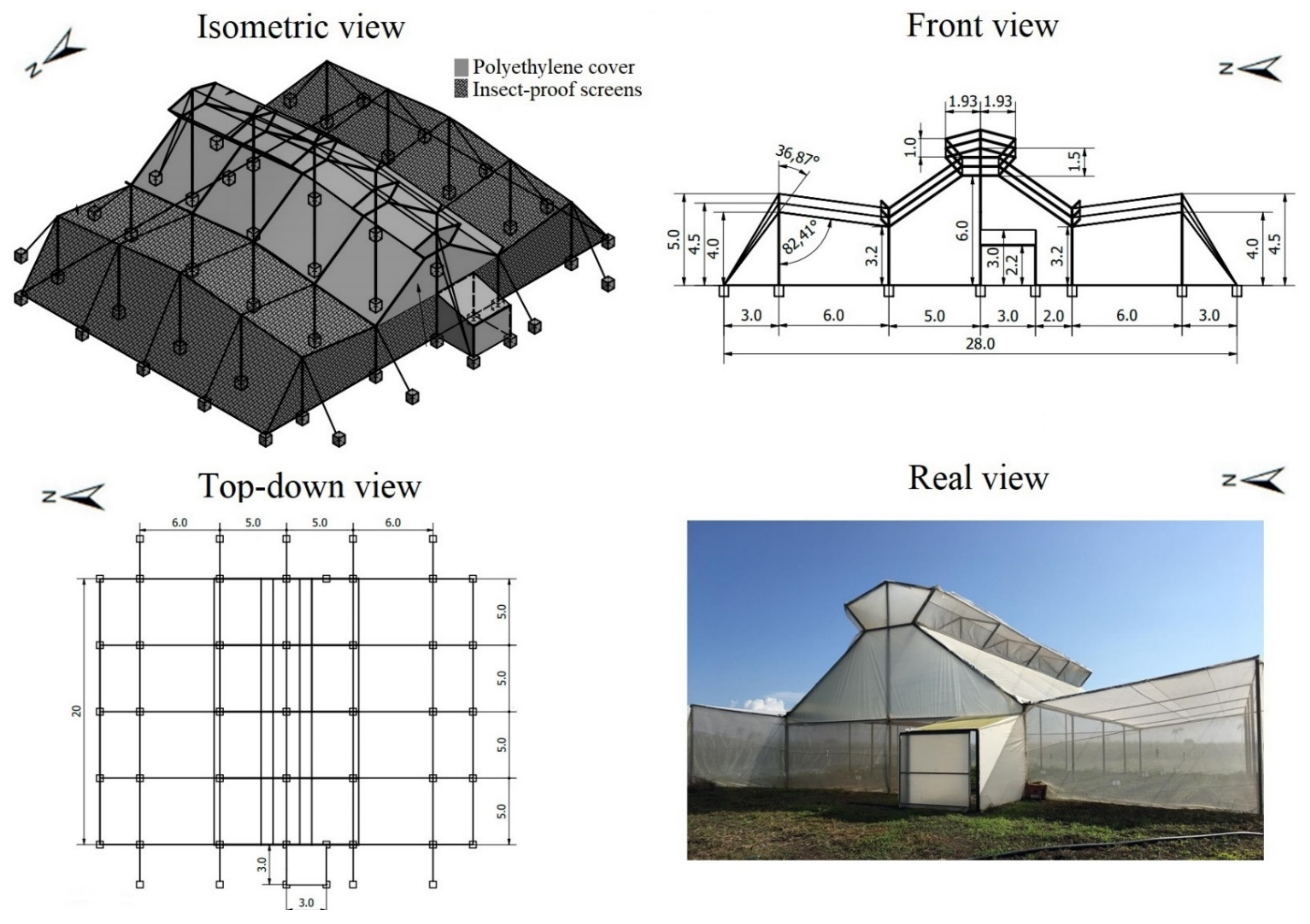

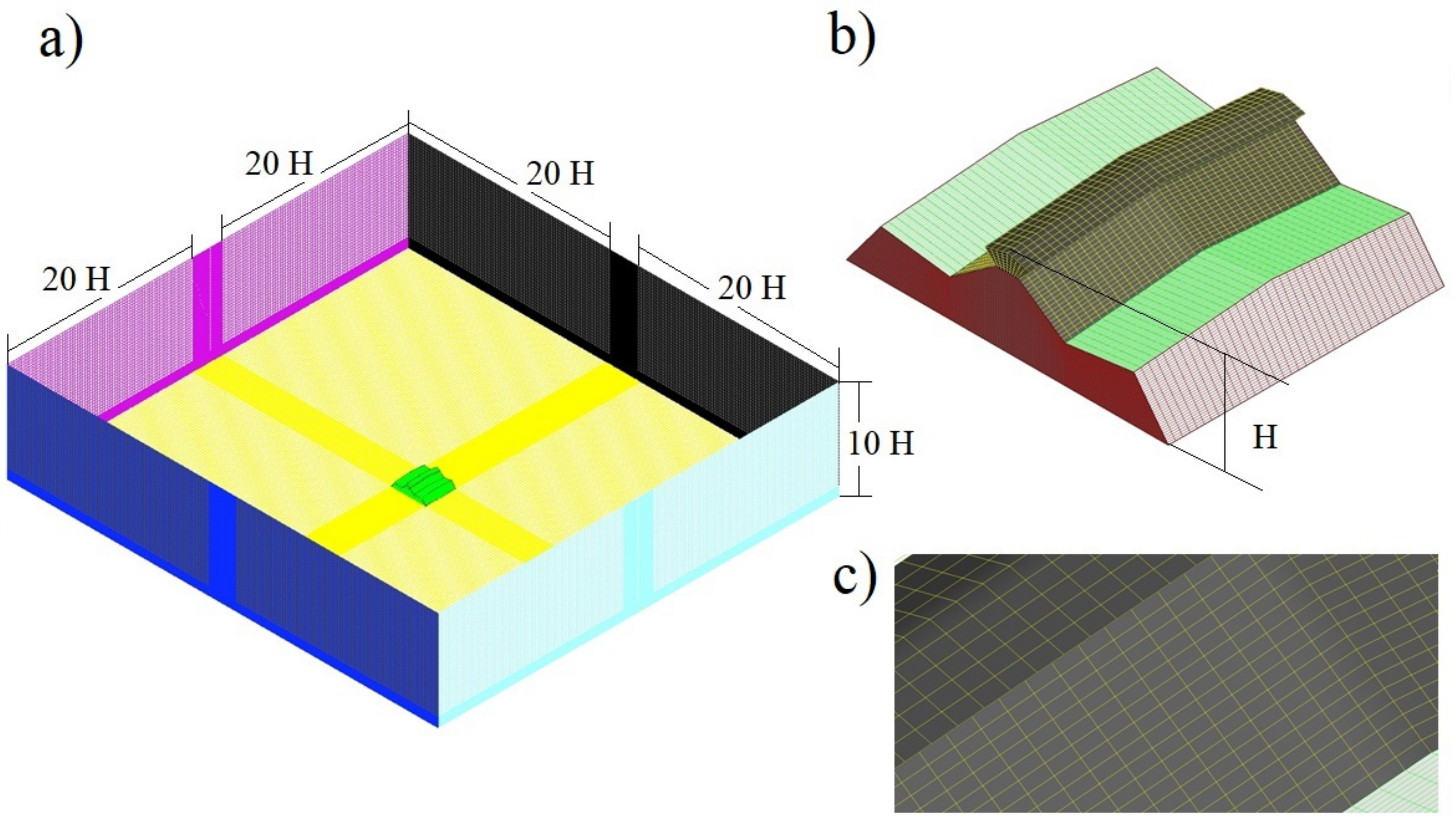
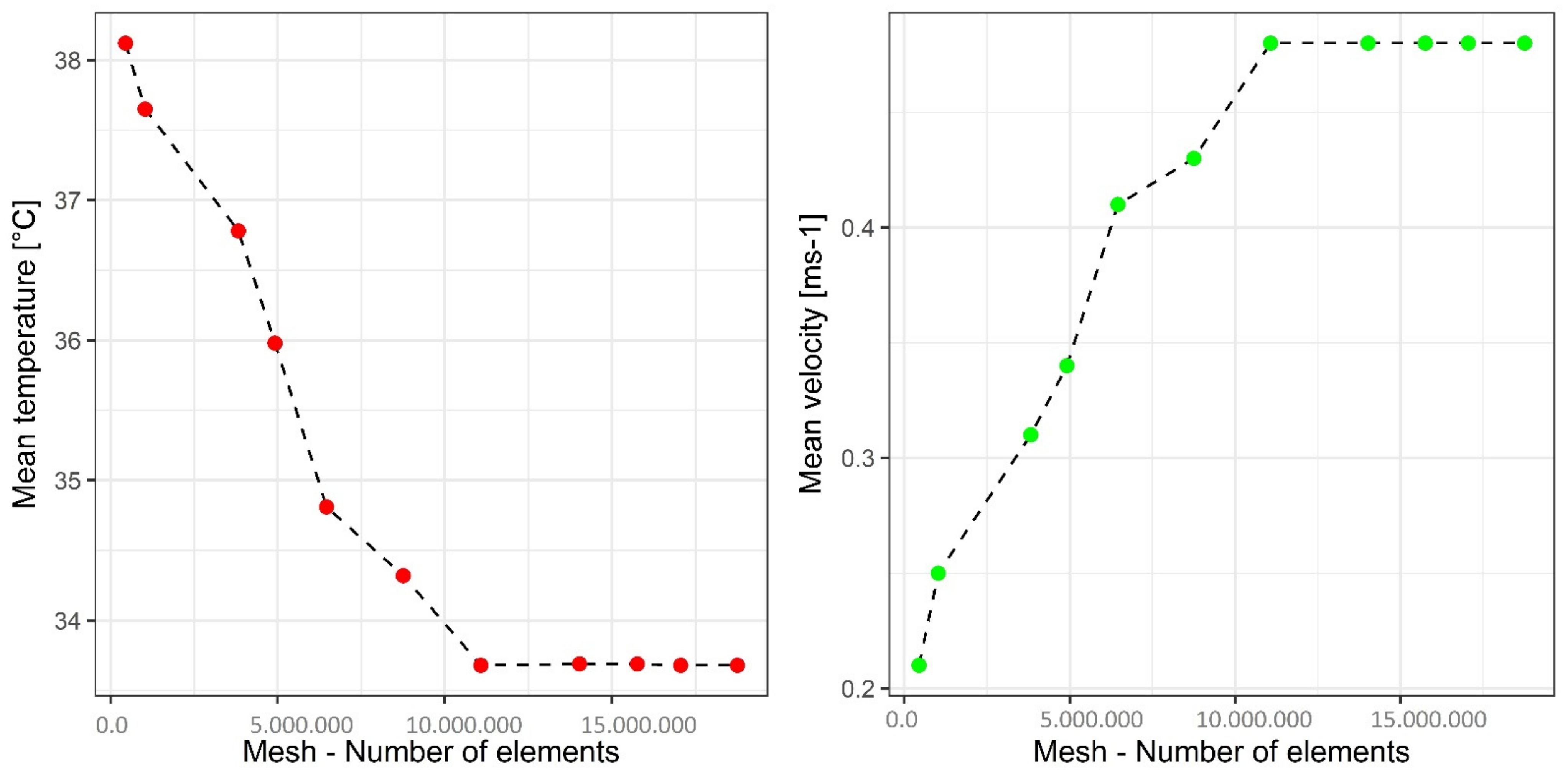
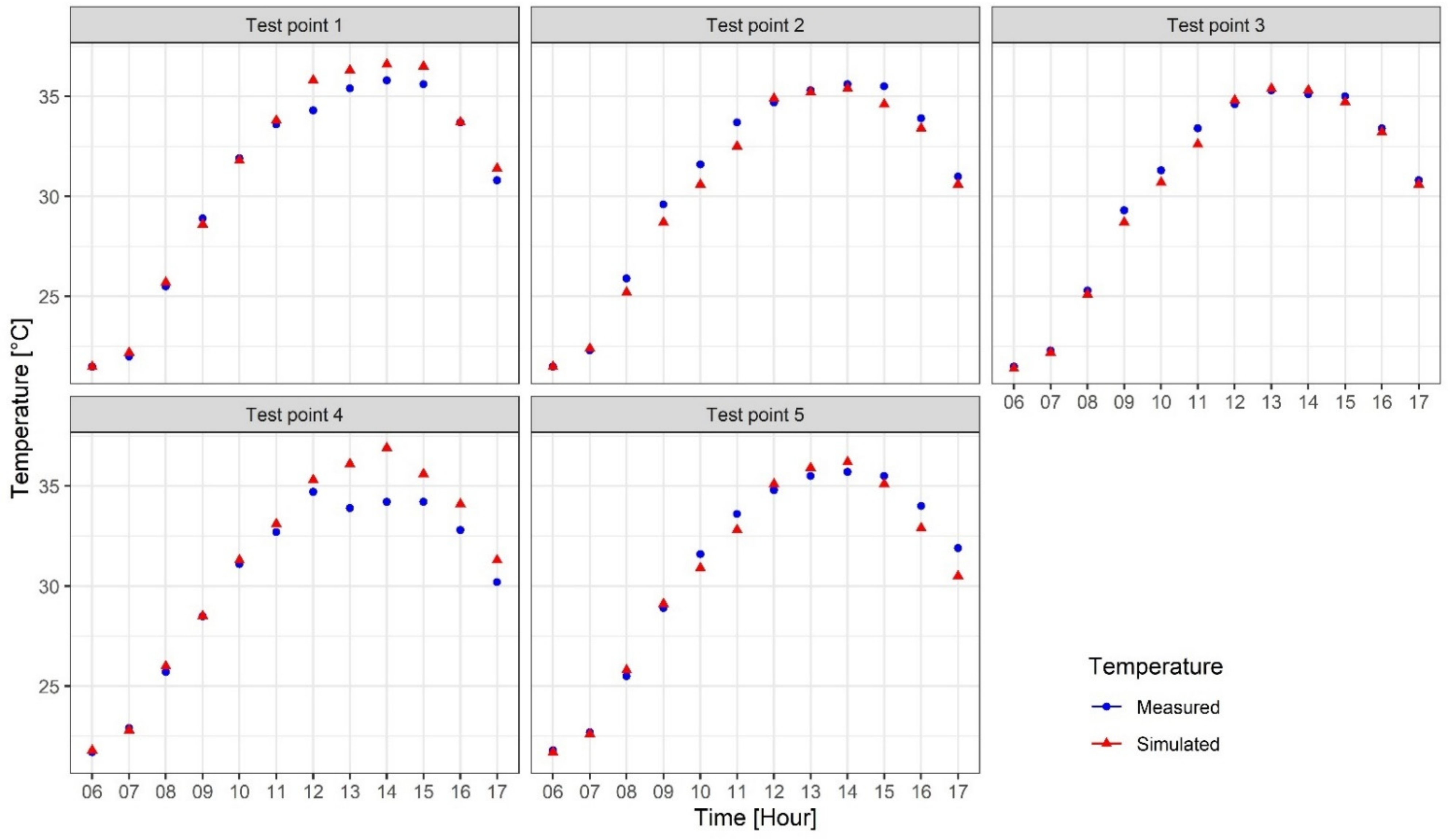
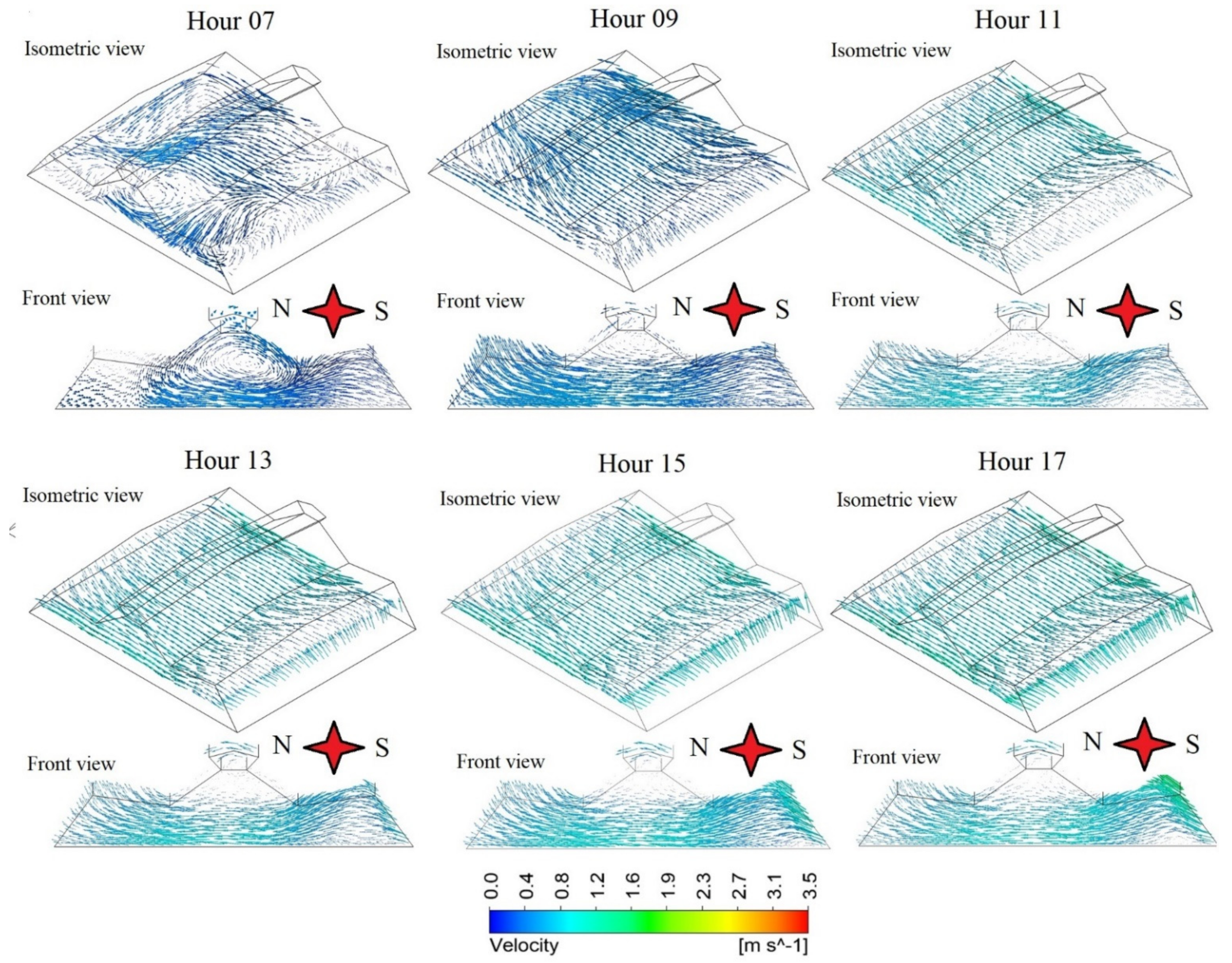
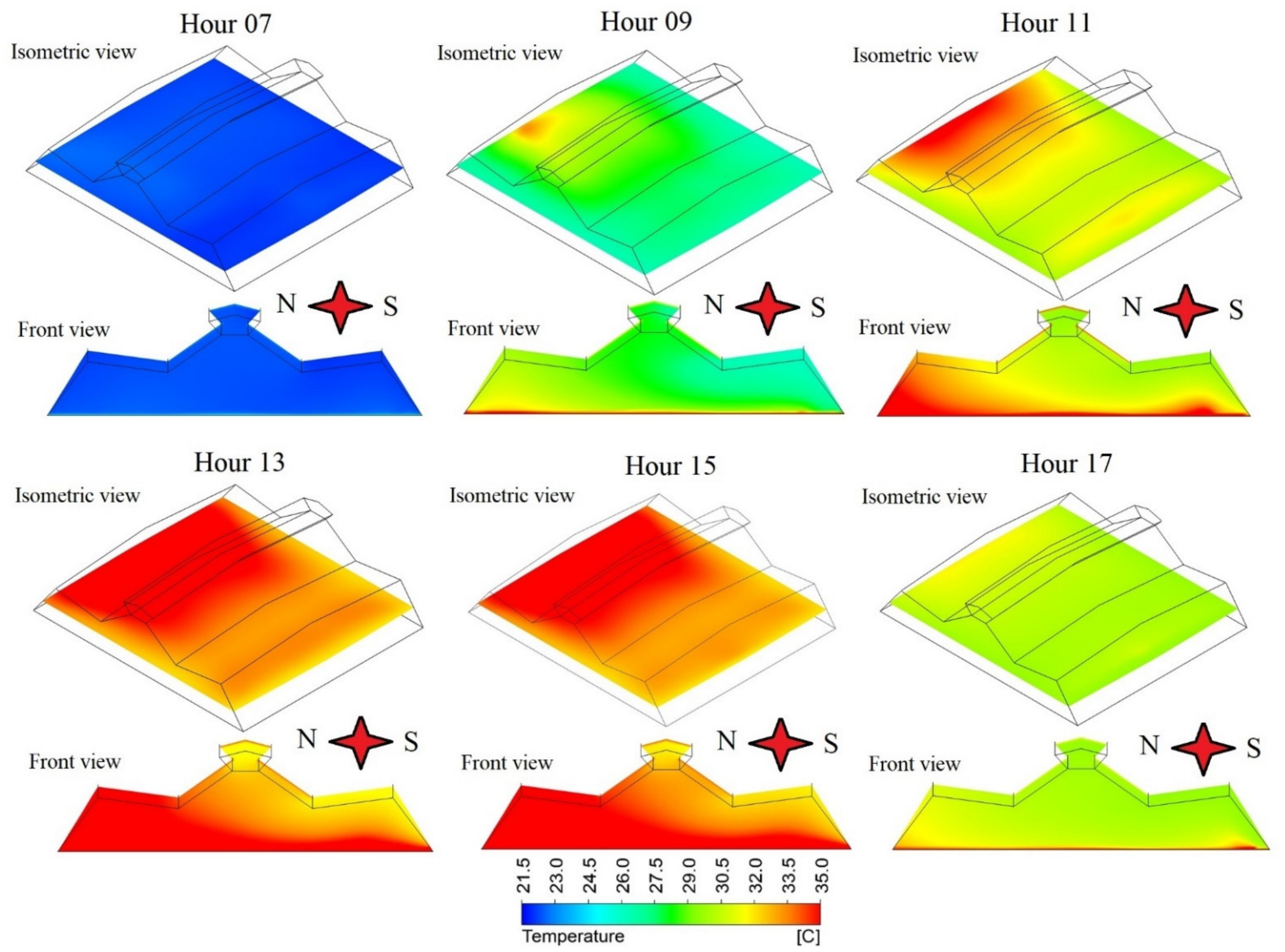
| Property | Air | Agricultural Soil | Polyethylene Cover |
|---|---|---|---|
| Density (ρ, kg m−3) | 1.225 | 1700 | 950 |
| Thermal conductivity (k, W m−1 K−1) | 0.0242 | 0.85 | 0.19 |
| Specific heat (Cp, J K−1 kg−1) | 1006.43 | 1010 | 1600 |
| Absorptivity coefficient | 0.10 | 0.5 | 0.15 |
| Refractive index | 1.0 | 1.92 | 1.7 |
| Emissivity | 0.86 | 0.90 | 0.85 |
| Hour | Air Temperature [°C] | Solar Radiation [W m−2] | Wind Velocity [m s−1] | Wind Direction |
|---|---|---|---|---|
| Hour 06 | 21.3 | 30.1 | 0.2 | ESE |
| Hour 07 | 21.8 | 66.1 | 0.3 | ESE |
| Hour 08 | 23.6 | 233.2 | 0.5 | S |
| Hour 09 | 25.6 | 448.2 | 0.7 | S |
| Hour 10 | 27.3 | 643.5 | 1.3 | S |
| Hour 11 | 28.7 | 793.9 | 1.9 | S |
| Hour 12 | 29.8 | 873.7 | 2.5 | S |
| Hour 13 | 30.5 | 859.7 | 3.1 | S |
| Hour 14 | 30.8 | 860.2 | 3.1 | ESE |
| Hour 15 | 30.8 | 732.5 | 3.3 | S |
| Hour 16 | 30.4 | 433.8 | 3.5 | ESE |
| Hour 17 | 29.4 | 211.6 | 3.3 | ESE |
| Test Point | RMSE [°C] | MAPE [%] |
|---|---|---|
| Test point 1 | 1.41 | 1.43 |
| Test point 2 | 1.61 | 1.63 |
| Test point 3 | 0.75 | 0.96 |
| Test point 4 | 2.94 | 2.64 |
| Test point 5 | 0.83 | 1.62 |
| Hour | Vm [m s−1] | U0 [%] | Hour | Vm [m s−1] | U0 [%] |
|---|---|---|---|---|---|
| Hour 06 | 0.14 ± 0.11 | 70.3 ± 17.1 | Hour 12 | 0.48 ± 0.22 | 19.2 ± 9.4 |
| Hour 07 | 0.19 ± 0.08 | 65.8 ± 29.6 | Hour 13 | 0.57 ± 0.21 | 18.3 ± 7.1 |
| Hour 08 | 0.21 ± 0.08 | 42.9 ± 16.3 | Hour 14 | 0.58 ± 0.20 | 18.5 ± 6.9 |
| Hour 09 | 0.31 ± 0.10 | 45.6 ± 14.6 | Hour 15 | 0.64 ± 0.22 | 19.6 ± 6.6 |
| Hour 10 | 0.51 ± 0.19 | 39.8 ± 14.7 | Hour 16 | 0.72 ± 0.23 | 20.6 ± 6.8 |
| Hour 11 | 0.52 ± 0.21 | 27.5 ± 11.4 | Hour 17 | 0.71 ± 0.24 | 21.6 ± 7.6 |
| Hour | T [°C] | ΔT [°C] | Hour | T [°C] | ΔT [°C] |
|---|---|---|---|---|---|
| Hour 06 | 21.6 ± 0.11 | 0.31 ± 0.11 | Hour 12 | 33.6 ± 2.22 | 3.88 ± 2.22 |
| Hour 07 | 22.2 ± 0.15 | 0.48 ± 0.15 | Hour 13 | 34.3 ± 2.25 | 3.89 ± 2.25 |
| Hour 08 | 24.9 ± 0.67 | 1.39 ± 0.67 | Hour 14 | 34.8 ± 2.33 | 4.02 ± 2.33 |
| Hour 09 | 28.1 ± 1.52 | 2.54 ± 1.52 | Hour 15 | 34.2 ± 2.20 | 3.38 ± 2.20 |
| Hour 10 | 29.7 ± 1.50 | 2.45 ± 1.50 | Hour 16 | 32.4 ± 1.27 | 2.02 ± 1.27 |
| Hour 11 | 31.5 ± 1.59 | 2.87 ± 1.59 | Hour 17 | 30.3 ± 0.59 | 0.92 ± 0.59 |
Publisher’s Note: MDPI stays neutral with regard to jurisdictional claims in published maps and institutional affiliations. |
© 2021 by the authors. Licensee MDPI, Basel, Switzerland. This article is an open access article distributed under the terms and conditions of the Creative Commons Attribution (CC BY) license (https://creativecommons.org/licenses/by/4.0/).
Share and Cite
Villagrán, E.; Rodriguez, A. Analysis of the Thermal Behavior of a New Structure of Protected Agriculture Established in a Region of Tropical Climate Conditions. Fluids 2021, 6, 223. https://doi.org/10.3390/fluids6060223
Villagrán E, Rodriguez A. Analysis of the Thermal Behavior of a New Structure of Protected Agriculture Established in a Region of Tropical Climate Conditions. Fluids. 2021; 6(6):223. https://doi.org/10.3390/fluids6060223
Chicago/Turabian StyleVillagrán, Edwin, and Andrea Rodriguez. 2021. "Analysis of the Thermal Behavior of a New Structure of Protected Agriculture Established in a Region of Tropical Climate Conditions" Fluids 6, no. 6: 223. https://doi.org/10.3390/fluids6060223






